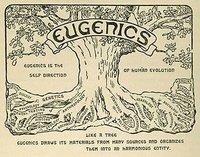Students Create Online Resources about the US Eugenics Movement

Editor’s note: Audrey Kalman reports on the project she and her classmates completed last spring in Kate Wiley’s senior-year history seminar at Lick Wilmerding High School in San Francisco. The seminar focused on the eugenics movement in the United States during the period between the first and second world wars.
Last spring, my peers and I created two websites to inform people about the history of the eugenics movement in the United States. In a seminar on the interwar years in America, we traced the eugenics movement’s fluctuating popularity between the world wars. We studied the origins of the movement rooted in “scientific” theories regarding race; the intertwinement of these theories with American law via legislation instituted during the Progressive Era; the horrors of forced, eugenically-motivated sterilization; and the decline of popularity of the eugenics movement in the US with the rise and atrocities of Nazi Germany.
We decided that creating a pair of online resources would allow us to share accurate information with a wide audience. The first site, History of Eugenics, is an online textbook that covers the eugenics movement from its genesis in Europe after the popularization of Darwinism, and moves through the eugenics movement in America up to the 1990s. The second, California's Place in American Eugenics, is an online exhibit that focuses on the eugenics movement in California, and on specific eugenic institutions in the state. The online exhibit also begins discussing the origins of eugenics in Europe, and the spread of these ideas to the US. It follows the movement up to 2003.
Many of my peers and I were already somewhat familiar with social movements, popular mindsets, and other significant changes in American life during the years between the wars after our junior year US History curriculum. It was especially striking to study eugenics in America in that context, beneath that surface level familiarity. Additionally, studying this movement within an interwar years scaffolding provided us with the opportunity to observe and analyze the conditions that worked to create a space in which such a movement could flourish.
We also spent a great deal of time analyzing the way we went about unearthing information and data about the many institutions that sterilized and even euthanized people in the US and specifically in California during this era. It was often difficult to find data that we believed to be accurate, and our findings were often filled with conflicting sources. In conducting most of our research, we had to look at slightly below-the-surface sources and definitely had to go off the more beaten path to find accurate accounts of these institutions.
We determined that this was not a surprising reality given that the actions of many of these institutions are so different from the assumptions about American Exceptionalism in most accounts of US history. This overly idealistic belief about America’s commitments to democracy and liberty is an unfortunately persistent and common perspective.
The central goal that guided our work was informing people about the history of the eugenics movement in America, especially in settings that they many believe they are familiar with, such as recent California history. We sought to shed light on the brutal and catastrophic changes that all too many institutions throughout the country inflicted upon their often unconsenting inmates. One of the primary reasons we created online resources was to inform people of this history as accurately as we could. We felt that online resources would be much more accessible than most other options, and a generally effective way to share information on this topic.
We researched and analyzed how other nations dealt with addressing such terrible histories, and we brainstormed and discussed how the US, and California, could potentially move towards a more honest reckoning with its history, specifically in regards to the eugenics movement. We believe this is an ongoing issue in a number of settings around the world.



